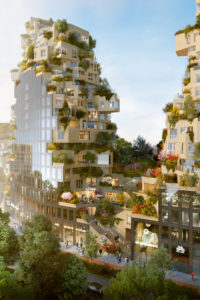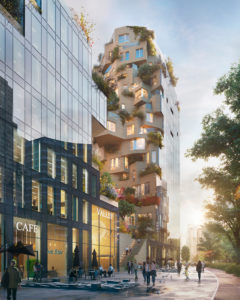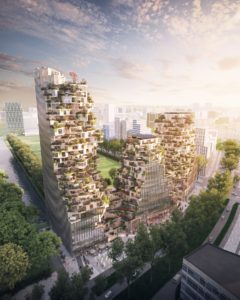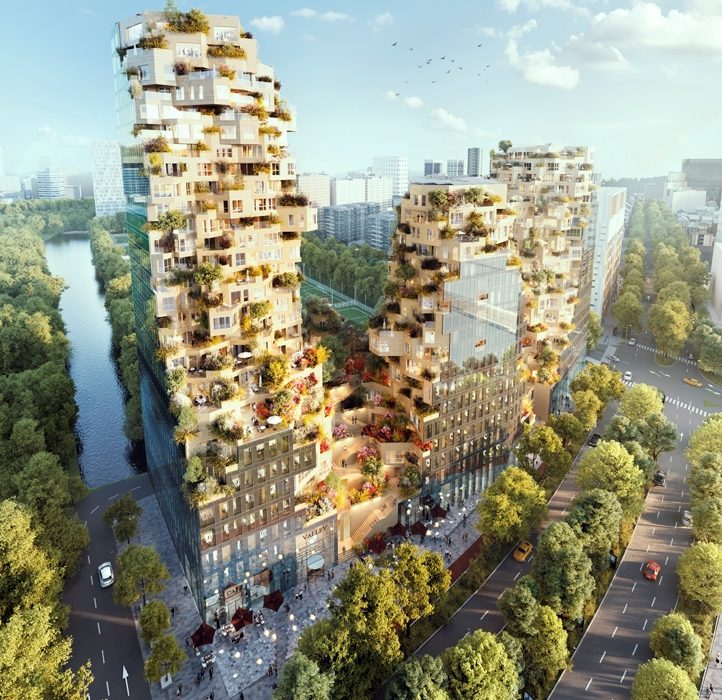Over a period of about two decades, the Zuidas area of Amsterdam, Netherlands emerged as the Netherlands primary international business center. But along the way, city planners forgot that vibrant urban business districts require sufficient residential capacity.
As a result, Zuidas became a typical “roll-up-the-sidewalks-at-5pm” area…a depopulated dead zone after working hours.
 Now, a major new redevelopment project called Valley intends to revitalize the area by restoring that missing ingredient: 24/7 habitation. It’s a key element in the city’s ambition to transform the area into a more livable and complete urban quarter. They want to welcome large numbers of residents, and—over the next decade—add the needed new public facilities to serve them.
Now, a major new redevelopment project called Valley intends to revitalize the area by restoring that missing ingredient: 24/7 habitation. It’s a key element in the city’s ambition to transform the area into a more livable and complete urban quarter. They want to welcome large numbers of residents, and—over the next decade—add the needed new public facilities to serve them.
Mid-August of 2017 marked the start of construction for Valley. It’s a 75,000m2, green-terraced, mixed-use building located in Zuidas.
Dutch design firm MVRDV’s competition-winning design for OVG Real Estate was selected by the Municipality of Amsterdam in 2015 and will include apartments, offices, an underground parking, a sky bar and various retail and cultural facilities. The design and programme mediates between human scale, nature and the atmosphere of the business district. Completion is set for 2021.
Valley’s three peaks of varied heights reach up to a maximum of 100 meters at which the publicly accessible Sky-bar sits, spread out over the top two stories, offering panoramic views over Amsterdam. The building consists of 196 apartments, 7 stories of offices, a three-story underground parking with 375 parking spots and various retail and cultural facilities.
From street level, a pedestrianised path, running along retails functions, terraces and roof gardens, leads up to the central valley-area spread across the 4th and 5th level and surrounds the central tower. Internationally renowned landscape architect Piet Oudolf designed all of Valley’s vegetation, focusing on a year-round green appearance. The project derives its name from this publicly accessible valley.
 Valley’s location is defined by transition. It sits on the border between residential and commercial functions. It forms the connection between green sports fields and the dense urban setting of the business centre and it initiates the change from the smaller scaled buildings of the inner city to the large volumes that define the South-axis. The concept of the building is rooted in this idea of transition. By placing the residential volumes on top of the multifunctional plinth and pushing them to the very edge of the envelope, the resulting volume reads as one single entity.
Valley’s location is defined by transition. It sits on the border between residential and commercial functions. It forms the connection between green sports fields and the dense urban setting of the business centre and it initiates the change from the smaller scaled buildings of the inner city to the large volumes that define the South-axis. The concept of the building is rooted in this idea of transition. By placing the residential volumes on top of the multifunctional plinth and pushing them to the very edge of the envelope, the resulting volume reads as one single entity.
In mirroring the corporate surroundings through of its reflecting glass exterior façade, the design acknowledges its corporate heritage and visually connects to its immediate neighbours. In direct contrast to this, the inner façade is defined by a series of rugged, stone terraces with large planters, covering the building in vegetation and bringing a sense of human scale to the volume. Through this opposing treatment of the facades, the duality of the resulting volume, which is reminiscent of a carved out block, is expressed: The corporate vs the residential. The XL vs the human scale.
“Valley combines residential apartments with a green environment that offers panoramic views of Amsterdam”, says Winy Maas, MVRDV co-founder. “A lively plinth offering a range of commercial activities has some offices above and is topped finally with residences. The carving out of the resulting block ensures that it becomes less introverted than existing buildings in the Zuidas. There will be many terraces, both private and public, filled with people, flowers, plants and outdoor seating.”
Publicly accessible from ground floor is the Grotto, a large interior space, fully clad in natural stone and lit by two great skylights that double as water filled ponds on the valley above. The Grotto serves as both a living room for the residents of Valley as well as a Grand Foyer for all other activities in the building, ensuring a lively atmosphere throughout the day.
 MVRDV’s design for Valley emphasises the contrast between the corporate history and the more residential future of the Zuidas. Its offices boast high floor-to-ceiling windows, large, brightly lit floorplates and full-service amenities.
MVRDV’s design for Valley emphasises the contrast between the corporate history and the more residential future of the Zuidas. Its offices boast high floor-to-ceiling windows, large, brightly lit floorplates and full-service amenities.
The residential levels have large openable windows and sliding doors for outdoor spaces integrated within the stone facades. Outdoor ceilings and terraces are clad in natural stone as well, as are the fixed, automatically hydrated planters of varying heights that facilitate Valley’s distinct green appearance. Full glass railings protect residents against wind and sound without impeding on their panoramic views.
The jagged, natural stone façade is defined by using a parametric tool developed in collaboration with Arup Amsterdam. This allowed for much needed real-time control over quantities of daylight and sunlight, over structural limitations and required privacy, amongst other things. The resulting overall variation of Valley’s building volume means that no two apartments are alike, creating a wide variety of housing types with unique plans for its inhabitants.
The abundance of outdoor spaces and communal green area’s promotes health and well-being whilst at the same time, contributes to the buildings green ambitions. In addition to a -0.3 EPC rating and a GPR score of 8, Valley will aim for a BREEAM-NL Excellent rating.
MVRDV worked together with Deltavormgroep & Piet Oudolf on landscape design, Van Rossum for structural engineering, Deerns for installations (HVAC), DGMR on building physics and energy efficiency strategy, and Inbo for construction engineering. The investor is the RJB Group of Companies and the contractors are G&S Bouw and Boele & van Eesteren.
Completion is set for summer of 2021.
All renderings courtesy of MVRDV.

